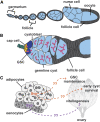The Nuclear Receptor Seven Up Regulates Genes Involved in Immunity and Xenobiotic Response in the Adult Drosophila Female Fat Body
- PMID: 33087412
- PMCID: PMC7718730
- DOI: 10.1534/g3.120.401745
The Nuclear Receptor Seven Up Regulates Genes Involved in Immunity and Xenobiotic Response in the Adult Drosophila Female Fat Body
Abstract
The physiology of organisms depends on inter-organ communication in response to changes in the environment. Nuclear receptors are broadly expressed transcription factors that respond to circulating molecules to control many biological processes, including immunity, detoxification, and reproduction. Although the tissue-intrinsic roles of nuclear receptors in reproduction have been extensively studied, there is increasing evidence that nuclear receptor signaling in peripheral tissues can also influence oogenesis. We previously showed that the Drosophila nuclear receptor Seven up (Svp) is required in the adult fat body to regulate distinct steps of oogenesis; however, the relevant downstream targets of Svp remain unknown. Here, we took an RNA sequencing approach to identify candidate Svp targets specifically in the adult female fat body that might mediate this response. svp knockdown in the adult female fat body significantly downregulated immune genes involved in the first line of pathogen defense, suggesting a role for Svp in stimulating early immunity. In addition, we found that Svp transcriptionally regulates genes involved in each step of the xenobiotic detoxification response. Based on these findings, we propose a testable model in which Svp functions in the adult female fat body to stimulate early defense against pathogens and facilitate detoxification as part of its mechanisms to promote oogenesis.
Keywords: Drosophila; Seven up; fat body; immunity; oogenesis; xenobiotics.
Copyright © 2020 Weaver, Drummond-Barbosa.
Figures





Similar articles
-
The nuclear receptor seven up functions in adipocytes and oenocytes to control distinct steps of Drosophila oogenesis.Dev Biol. 2019 Dec 15;456(2):179-189. doi: 10.1016/j.ydbio.2019.08.015. Epub 2019 Aug 27. Dev Biol. 2019. PMID: 31470019 Free PMC article.
-
Hormone receptor 4 is required in muscles and distinct ovarian cell types to regulate specific steps of Drosophila oogenesis.Development. 2021 Mar 9;148(5):dev198663. doi: 10.1242/dev.198663. Development. 2021. PMID: 33547134 Free PMC article.
-
The DHR96 nuclear receptor regulates xenobiotic responses in Drosophila.Cell Metab. 2006 Jul;4(1):37-48. doi: 10.1016/j.cmet.2006.06.006. Cell Metab. 2006. PMID: 16814731
-
Induction of phase I, II and III drug metabolism/transport by xenobiotics.Arch Pharm Res. 2005 Mar;28(3):249-68. doi: 10.1007/BF02977789. Arch Pharm Res. 2005. PMID: 15832810 Review.
-
Nuclear hormone receptors: Roles of xenobiotic detoxification and sterol homeostasis in healthy aging.Crit Rev Biochem Mol Biol. 2015;50(5):380-92. doi: 10.3109/10409238.2015.1067186. Epub 2015 Sep 18. Crit Rev Biochem Mol Biol. 2015. PMID: 26383043 Review.
Cited by
-
Cisplatin toxicity is counteracted by the activation of the p38/ATF-7 signaling pathway in post-mitotic C. elegans.Nat Commun. 2023 May 20;14(1):2886. doi: 10.1038/s41467-023-38568-5. Nat Commun. 2023. PMID: 37210583 Free PMC article.
-
Chili-supplemented food decreases glutathione-S-transferase activity in Drosophila melanogaster females without a change in other parameters of antioxidant system.Redox Rep. 2022 Dec;27(1):221-229. doi: 10.1080/13510002.2022.2123884. Redox Rep. 2022. PMID: 36200601 Free PMC article.
-
Immunomodulation, Toxicity, and Therapeutic Potential of Nanoparticles.BioTech (Basel). 2022 Sep 9;11(3):42. doi: 10.3390/biotech11030042. BioTech (Basel). 2022. PMID: 36134916 Free PMC article. Review.
-
Origin and Development of the Adipose Tissue, a Key Organ in Physiology and Disease.Front Cell Dev Biol. 2021 Dec 21;9:786129. doi: 10.3389/fcell.2021.786129. eCollection 2021. Front Cell Dev Biol. 2021. PMID: 34993199 Free PMC article. Review.
-
Metal ions in insect reproduction: a crosstalk between reproductive physiology and immunity.Curr Opin Insect Sci. 2022 Aug;52:100924. doi: 10.1016/j.cois.2022.100924. Epub 2022 Apr 25. Curr Opin Insect Sci. 2022. PMID: 35483647 Free PMC article. Review.
References
-
- Arizono K., Kagawa S., Hamada H., and Ariyoshi T., 1995. Nitric oxide mediated metallothionein induction by lipopolysaccharide. Res. Commun. Mol. Pathol. Pharmacol. 90: 49–58. - PubMed
Publication types
MeSH terms
Substances
Grants and funding
LinkOut - more resources
Full Text Sources
Molecular Biology Databases
